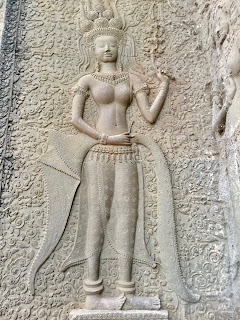One of the main reasons we decided to visit Cambodia was to see the world famous Angkor Wat temple. This temple is a national treasure that is featured on the country flag, and is the pride of the Cambodian people. It has been in continuous use since it was built, and unlike some of the other temples, it has never been abandoned to the elements of the jungle.
Angkor Wat was built by Khmer King Suryavarman II early in the 12th century. He built the temple to honor the Hindu God, Vishnu. It is also believed that the king intended to use Angkor Wat for his mausoleum, however he was never buried inside it. It only took about 37 years to complete the construction of the temple, which is truly remarkable. Creating it involved approximately 300,000 workers, which included architects, construction workers, masons, sculptors and servants who were used to feed the workers. Six thousand elephants also assisted with the construction of the site. Five to ten million sandstone blocks used to build the structures were quarried 25 miles or more away and floated down canals on rafts. The maximum weight of each block would have been roughly 1.5 tons. The buildings and towers were constructed using no mortar between the blocks.
Eleanor Mannikka, explains in her book, Angkor Wat: Time, Space and Kingship, that the temple was built like other temple mountains, to replicate the spatial universe in miniature. The central tower is Mt. Meru, with the shorter towers representing the surrounding peaks...the lower courtyards represent the continents...and the moat represents the oceans. Although Angkor Wat was first built as a Hindu temple, it later became a Buddhist temple, and remains one today.
 |
Vasuki, one of the King serpents of Hindu and Buddhist religions,
guards the entrance to the bridge entrance to Angkor Wat. |
 |
| One of three entrances to the temple. |
 |
| The eight armed statue of Vishnu/Buddha stands in a small room on the outer wall of Angkor Wat. |
Below is a picture of an Apsaras...a heavenly nymph. There are more than 2,000 nymphs carved into the walls of Angkor Wat. Each one is unique with different patterns on their clothes, or different poses, jewelry, hair styles or hair ornaments. They are a delight to look at.
 |
| The peaks you see on the towers are the heads of serpents. |
 |
One of eight pools found inside the structure. There are four pools on the first level of the temple
and four more pools inside the middle tower. |
 |
| Views looking down from inside the middle tower. |
 |
| Sculptures can be found throughout the temple on nearly every surface of the buildings. |
 |
| Tourist friendly stairs leading up and down from the middle tower. |
 |
| One of several libraries found on the grounds. |
Below are several photos of bas-relief scenes found on serveral of the walls of Angkor Wat.
 |
Photos above and below...A sinner being driven full of nails in a depiction of hell.
This is a part of the san-relief scenes depicting Heaven and Hell. |
 |
| Monkeys can be spotted on the roof of the temple and the surrounding areas. |
 |
Lance and I with our tour guide for the day...Chann Dok Dara Veachear.
He also teaches school. |




































No comments:
Post a Comment